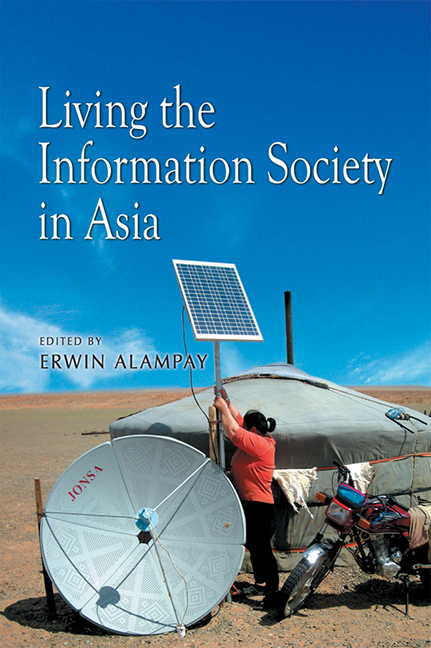Book contents
- Frontmatter
- Contents
- Foreword
- Preface
- List of Abbreviations
- Contributors
- Introduction: Perspectives of ICT Research in Asia
- 1 What Would Durkheim Have Thought? Living in (and with) the Information Society
- 2 What Is a Mobile Phone Relationship?
- 3 Technologies of Transformation: The End of the Social or the Birth of the Cyber Network?
- 4 Becoming Mobile in Contemporary Urban China: How Increasing ICT Usage Is Reformulating the Spatial Dimension of Sociability
- 5 Mobile Religiosity in Indonesia: Mobilized Islam, Islamized Mobility and the Potential of Islamic Techno Nationalism
- 6 Moral Panics and Mobile Phones: The Cultural Politics of New Media Modernity in India
- 7 Stories from e-Bario
- 8 Life and Death in the Chinese Informational City: The Challenges of Working-Class ICTs and the Information Have-less
- 9 Institutional Responses to GIS Adoption for RPTA in Local Governments
- 10 Customer Acquisition among Small and Informal Businesses in Urban India: Comparing Face-to-Face and Mediated Channels
- 11 The View from the Other Side: The Impact of Business Process Outsourcing on the Well-being and Identity of Filipino Call Centre Workers
- 12 Empowering Thai Homeworkers through ICTs
- Index
4 - Becoming Mobile in Contemporary Urban China: How Increasing ICT Usage Is Reformulating the Spatial Dimension of Sociability
Published online by Cambridge University Press: 21 October 2015
- Frontmatter
- Contents
- Foreword
- Preface
- List of Abbreviations
- Contributors
- Introduction: Perspectives of ICT Research in Asia
- 1 What Would Durkheim Have Thought? Living in (and with) the Information Society
- 2 What Is a Mobile Phone Relationship?
- 3 Technologies of Transformation: The End of the Social or the Birth of the Cyber Network?
- 4 Becoming Mobile in Contemporary Urban China: How Increasing ICT Usage Is Reformulating the Spatial Dimension of Sociability
- 5 Mobile Religiosity in Indonesia: Mobilized Islam, Islamized Mobility and the Potential of Islamic Techno Nationalism
- 6 Moral Panics and Mobile Phones: The Cultural Politics of New Media Modernity in India
- 7 Stories from e-Bario
- 8 Life and Death in the Chinese Informational City: The Challenges of Working-Class ICTs and the Information Have-less
- 9 Institutional Responses to GIS Adoption for RPTA in Local Governments
- 10 Customer Acquisition among Small and Informal Businesses in Urban India: Comparing Face-to-Face and Mediated Channels
- 11 The View from the Other Side: The Impact of Business Process Outsourcing on the Well-being and Identity of Filipino Call Centre Workers
- 12 Empowering Thai Homeworkers through ICTs
- Index
Summary
INTRODUCTION
Transitional urban China is characterized by changing spatial and social patterns. The slow disappearance of Maoist social structures leads to more open social networks that have spatial impact. Individuals are now freer to develop their own strategies, in terms of jobs, housing preferences, social belongings, etc. In this context, what is the role played by, specifically the Internet and the mobile phone?
CURRENT KNOWLEDGE ON URBAN MOBILITY IN CHINA
Urban mobility is more and more residence-based: Since 1992, Chinese urban dwellers are investing massively in the purchase of their home. This purchase is determined by the level of revenue of each individual but also by location preferences (some neighbourhoods are more fashionable than others). Emphasis on the residential location leads to a residence-based mobility instead of the former work-based mobility of the Maoist era organized around the work unit, the danwei.
Travel distances are increasing: In Maoist urban China, travel distances were limited because of a strong geographical integration of work and residence. This integration was organized within the work unit (danwei). Each individual could find housing and services provided by his/her work unit. Due to reforms, the work units are becoming obsolete, losing their role in providing social services. Today, companies have less control over the residential location of their employees: work places and residential places are scattered in the urban spaces, leading to longer travel distances.
Travel patterns reveal less confinement to the space of proximity: Proximity no longer ensures finding the services or products individuals need. In a more specialized urban space, individuals need to have a broader knowledge of the city to know where the best places (i.e. best shopping malls, best bars, best restaurants, etc.) are and how to optimize their needs.
Travel motives are more diverse: For decades, travel motives were essentially centred on home-to-work transits. Today, because of a more individual-based society and the multiplication of leisure-oriented activities, people are diversifying their urban experiences. Trips to job, school and shops remain the most common travel motives; however, for an increasing number of individuals, leisure motives are working their way up.
- Type
- Chapter
- Information
- Living the Information Society in Asia , pp. 57 - 72Publisher: ISEAS–Yusof Ishak InstitutePrint publication year: 2009

